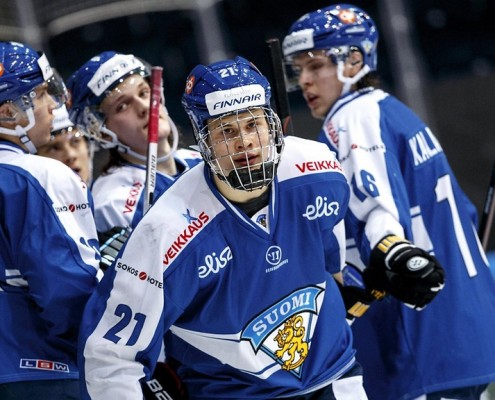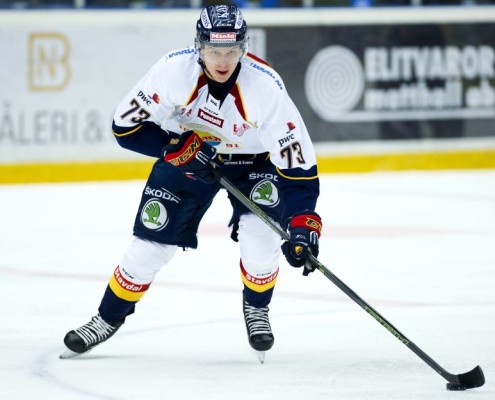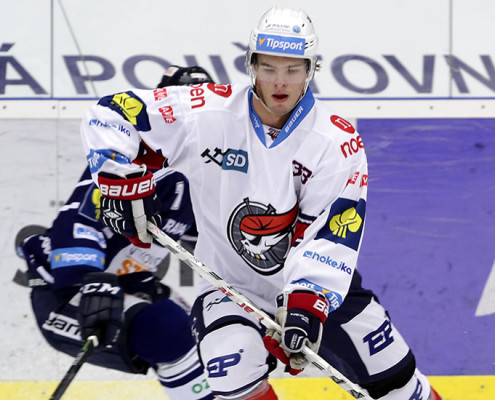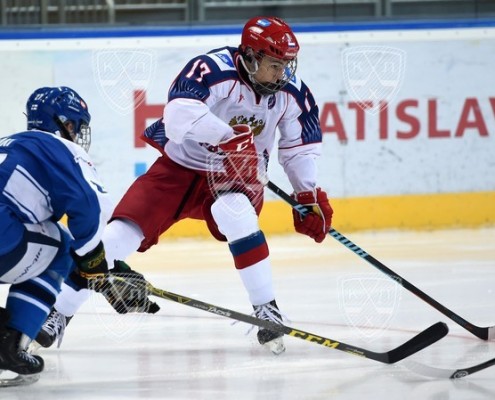U20 Four Nations Tournament
Tampere, Finland
November 6-8, 2015
Finland
Finland Team Roster / Player Stats / Tournament Scoring Leaders / Tournament Goalie Leaders
Tampere, Finland (The Draft Analyst) — The host Finns were expected to put on a show for a variety of reasons. And while their entry for the tournament may not have been as star-studded as rival Sweden’s, its ability to boast two of the best under-18 players in the world certainly added a little kick to an already tasty platter of prospects. Wingers Patrik Laine and Jesse Puljujarvi – arguably the most sought-after Europeans from one draft since Alex Ovechkin and Evgeni Malkin in 2004 – respectively put on a show for the home crowd, and against older competition no less. Finland coasted to a perfect 3-0 record in the tournament, capped with a convincing win over the hated Swedes.
To get there, however, the Finns were nearly bested in their opening game by a pesky Czech squad which nearly pulled off an upset before Puljujarvi dazzled with a goal off the rush which embodied his unique blend of power, grace and skill, thus erasing a one-goal deficit and setting the stage for center Roope Hintz to jump on a loose puck, dance around three defenders and wire a shot under a sliding Vejmelka’s glove. 2016 draft hopeful Veini Vehvilainen, who could be a wild card for the WJC team, stopped a handful of quality chances in picking up the victory. In their 2-0 win against Russia, the task of keeping the locals happy fell on Larmi’s shoulders, and his stop on Korshkov’s penalty shot allowed defenseman Robin Salo to break the deadlock with a deep wrister off a heads-up pass near the wall by an observant Sebastian Repo. Youngster Kasper Bjornqvist capped the scoring with a power drive-and-protect move to the cage, where he banged home his own rebound while crashing away towards the boards.
The aforementioned win against Sweden, however, was Finland’s best performance, and both Puljujarvi and Laine stepped up with timely strikes for a 4-1 triumph. Puljujarvi opened the scoring in the second with a quick snap shot following a corner centering feed from Repo, and Laine converted a perfectly-executed 3-on-2 after Aleksi Saarela stripped the Swedish Sebastian Aho at the latter’s blue line, allowing the Finnish Sebastian Aho to feed Laine for the slam dunk. Looke and Laine closed out the scoring, with Laine firing a game-high eight shots as the Finns claimed the tournament title.
Top Forward: He might not be a popular choice, but right wing Sebastian Repo displayed world-class vision and heads-up play while playing in a variety of situations on a bunch of different lines. He’s got a pro-winger’s build (6’2, 190 lbs) and can play either wing or center. Repo is technically a double-overager, but a late-June birthday separates from most 1996-born prospects in that you don’t lose a full year of development. A Sioux City Musketeer in 2015, Repo has been one of the Finnish Liiga’s nice rookie surprises with six goals and 12 points in 21 games.
Top Defenseman: Salo was to our knowledge the youngest player of any country at the Four Nations, yet certainly didn’t play like he was. Salo is not only draft eligible until 2017 (October, 1998 birthday), but he’s also playing in Finland’s senior league, which obviously helped him deal with U20 types in Tampere. He was decisive with his passes and used what looked like some serious leg drive to seal players off. And Salo can seriously bring it, which is why Samsonov may have misjudged the goal he gave up to him.
Russia
Russia Team Roster / Player Stats/ Tournament Scoring Leaders / Tournament Goalie Leaders
We don’t like to mince words, so saying Russia displayed one of its worst U20 performances of any kind for quite a while should be enough. And though some may say it’s an unfair judgment when you consider the lineup was impacted by the concurrent Canadian Hockey League’s Canada-Russia series, a lineup with names like Denis Guraynov, Kirill Kaprizov, Ilya Samsonov and Mikhail Vorobyov should have produced far better results than the 1-2 record which is actually a misrepresentation of how un-Russian like their effort was.
The tournament began well with a surprising 3-2 overtime win over Sweden, with talented forward Artem Zhelezkov tying the score late in the third before 6’3 bruiser Yegor Korshkov won it in the extra session. The Russians were lucky to walk away with a victory, as the Swedes and their arsenal of NHL draft picks held their opponents to only 16 shots on goal. The lackluster play exhibited in the win over Sweden caught up with Russia the following night against host Finland, as Washington Capitals 2015 first round pick Ilya Samsonov faced a barrage of shots, especially with his team shorthanded in what ended as a 2-0 loss. For all its problems dealing with the quicker Finns, Russia almost took the lead late in the first when Korshkov was rewarded a penalty shot. But Emil Larmi didn’t fall for Korshkov’s backhand-forehand deke, keeping the game scoreless until the second, when Samsonov let in a questionable goal from an unscreened, blue line snap shot.
Their finale against the Czech Republic began well, with Zhelezkov bombing down the left wings boards and ripping a shot past Karel Vejmelka for Russia’s first lead in regulation of the tournament. But sloppy passing on the power play and an addiction to dump-and-chase hockey simply presented the Czechs with the opportunity to seize the initiative, which they beginning with a late goal in the first period. Center German Rubstov — a possible first round pick in the 2016 NHL draft — and winger Kirill Kaprizov showcased chemistry throughout the match, with Rubtsov winning a team-high 50 percent of his draws. But both the match and the tournament as a whole has to be considered a significant disappointment.
Top Forward: Zhelezkov showed a lot of fight and smarts, playing much bigger than his 5’11 frame may indicate. He took the puck to the net on the rush, but also did not shy away from the more difficult areas near the net. He was not on the roster for the U20 Four Nations back in August, when Russia was the host country. But a promotion to the KHL’s Magnitogorsk Metallurg has obviously helped this double overager in terms of confidence and thinking the game one and two plays ahead. The problem for Zhelezkov is that Russia has too many forwards of his ilk, so it may be too late for his Four Nations’ performance to earn a job at the WJC’s.
Top Defenseman: The group had a tough time dealing with speed headed their way, and too many of their passes were telegraphed. And even though they were hemmed in their own end without displaying much creativity in eluding pressure, the play of former Chicoutimi blueliner Nikita Lyamkin was relatively calming (horrid singular turnovers against the Czechs and Swedes, notwithstanding). He’s also a double overager who’s in his last year of draft eligibility, and was the 21st overall pick in the 2013 CHL Import Draft. The two years the 6’4 defender essentially spent as a pylon in the QMJHL must have helped him identify what used to be major deficiencies, although he’s still extremely raw.
Sweden
Sweden Team Roster / Player Stats / Tournament Scoring Leaders / Tournament Goalie Leaders
The team with the most recognizable names belonged to Sweden, which boasted a roster 75 percent comprised of recent NHL draft picks. But as we all know, games are won on the ice, where the opposing team has a say too. A solid effort in the opening match with Russia went for naught, as the Swedes controlled play but paid the price for not building on a pair of one-goal leads before ultimately losing in overtime, 3-2. They bounced back with a 6-0 rout of the Czech Republic, but the game may have been a lot closer had it not been for Lukes’ shaky play in the Czech goal. The most notable aspect of the Swedes’ game was their ability to make the Czechs pay for every mistake made following heavy pressure on the forecheck. The likes of Robin Kovacs, Jens Looke and Anton Karlsson used their speed in conjunction with Sweden’s air-tight zone coverage to force Czech defenders into moving the puck through the middle of the ice, where it was routinely picked off and fired on goal by active blueliners like Gustav Forsling and Sebastian Aho. Goalie Linus Soderstrom was solid in net, showing excellent side-to-side quickness and recovery during a hectic opening frame which the Czechs spent the duration in the Swedish end. Kovacs, the New York Rangers’ draft pick who scored a crucial goal in a comeback win over the Czech Republic in last August’s Four Nations, turned the game into a laugher with a pair of highlight-reel goals.
The Swedes want to beat Finland more than any opponent, and the fact that the final game of the competition pitted the two rivals was not lost in the hoopla surrounding the elite amateurs who participated. Sweden, however, may have been lulled by Finland’s game of possum during the first 20 minutes until wunderkinder Puljujarvi and Laine changed the game’s complexion with one-timers past goalie Erik Kallgren. The 4-1 loss was disappointing to say the least, as a victory would have not only won Sweden the tournament, but accomplished in front of their rivals’ home crowd.
The names Sweden provided for the Tampere tournament resembled a WJC roster more so than any of their three opponents, which explains the subtle disappointment among Swedish hockey circles. But to be fair, the Four Nations is generally a pre-WJC tune-up used more for assessment purposes over bragging and boasting. Two 2016 draft eligibles – center Rasmus Asplund and right wing Carl Grundstrom – played well in defense-oriented roles, with Asplund dominating on draws at a 71 percent clip.
Top Forward: Kovacs has blossomed into a lethal top-line threat, producing a tournament-best three goals and tying Holmstrom for the scoring lead with four points in three games. In a possession-crazed world, Kovacs is most certainly a driver, and his high shot totals are more indicative of a smart winger who knows how to elude defenders and get his stick at the ready. We think he’s a lock for the World Juniors, and his recent SHL promotion from the Allsvenskan shows the Four Nations was far from a fluke. His hard work and improved shot selection has obviously paid off.
Top Defenseman: Adam Ollas Mattson may not have torched the score sheet (zero points in three games), but he was the most active and reliable Swede on the back end. Selected by Calgary in the sixth round of the 2014 draft, Ollas Mattson is slowly taking chances in the offensive zone in an attempt to be a well-rounded defenseman and shed a reputation of only being a stay-at-home type. He’s a big kid (6’4 / 210 lbs) who did not display an proclivity for north-south mobility, but he was very active and kept his feet moving during play in the opposing end, where he even dropped down into the slot for scoring opportunities.
Czech Republic
Czech Republic Team Roster / Player Stats/ Tournament Scoring Leaders / Tournament Goalie Leaders
The Czech Republic entered the fall installment of the Four Nations’ tournament much like the way they began the one in August – without their top players who were committed to North America. The Czechs opened the competition with a 3-2 loss to Finland in a game they led by a goal after 40 minutes and were seemingly in control of until a costly tripping call on defenseman Jan Skotka before the midway point of the third period. Finnish star Jesse Puljujarvi then burst through a matador defense on an end-to-end rush for the tying score, and Roope Hintz scored the eventual game winner a few minutes later after he won a 50/50 battle against undersized defenseman David Skelnicka, and danced around defenseman Filip Hronek’s half-hearted check before beating goalie Karel Vejmelka on the long side.
Their effort in a 6-0 loss to Sweden the following night was not poor by any means, as backup goalie Stepan Lukes was absolutely putrid in being directly responsible for all six goals against. The Czechs dominated the first 20 minutes, outshooting the Swedes 14-7 and receiving quality chances from the likes of right wing Vit Christov, who schooled veteran defenseman Gustav Forsling in a one-on-one situation that led to a partial breakaway. Hronek spearheaded the Czech power play, which went 0-for-3 in the first period but had several good looks on Swedish netminder Linus Soderstrom. Lukes, however, could not get into any sort of rhythm, and the Swedes took advantage of poor rebound control, poor positioning and what seemed like an overall lack of awareness. The Czechs did however outshoot Sweden 30-20 over the final 40 minutes, led by the dynamic top-line play of Chomutov wingers Radek Vesely and David Kase, who flanked center Dominik Lakatos.
The Czech Republic won their final match of the tournament – a 3-2 win over Russia in which the Czechs found themselves trailing early and killing a four-minute power play late. A key step-up by Skelnicka following a successful kill sprung the speedy Vesely, who walked in alone and beat Alex Georgiev to knot the score. Defenseman Alex Rasner drove the play on the tiebreaking score after he rushed up the ice and shot the puck on goal, and Hronek’s bomb off the rebound was kicked over to Lakatos for the tap-in. The Czechs sealed the win on a pretty tic-tac-toe goal set up by both Kase and Hronek, and finished by center David Tomasek.
Top Forward: Vesely was hard to contain in any of the three matches and displayed a hunter’s mentality during opposing breakouts. A double-overager in terms of draft eligibility, the 6’1 Vesely also produced at the summer Four Nations in Russia and was invited to the WJC camp in Calgary. He may not be a top line option for the U20 squad come December in Helsinki, but his speed and finishing ability makes him a good depth option for what should be a balanced Czech roster.
Top Defenseman: Hronek, a late-1997 puck mover with a cannon of a shot, displayed a fine touch and razor-sharp instincts while utilizing jukes, dekes and head fakes to open clogged passing and shooting lanes. Hronek displayed a lot of flash, even no-looking a perfect feed through a maze of sticks to set up the eventual game winner against Russia. Yes, he had trouble dealing with the bigger, older forwards on the attack, but he did try his best to play physical and use his body to separate them from the puck. His set-ups on the power play are excellent; he lays the puck flat and in perfect position for either a one-timer or touch pass. He may not have performed well enough to make the World Junior club, but he’s still one of the better offensive-minded blueliners the Czechs will offer at the Entry Draft in June.






